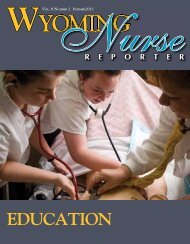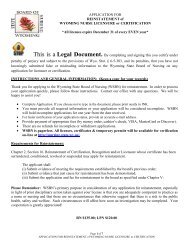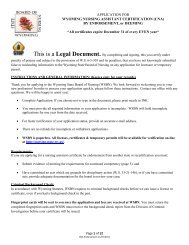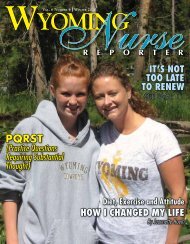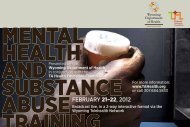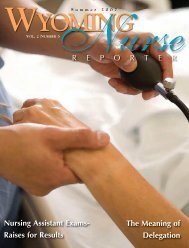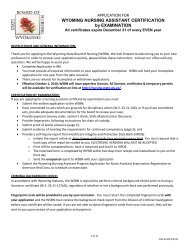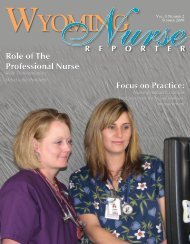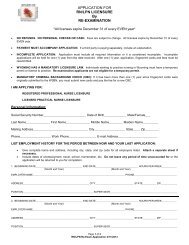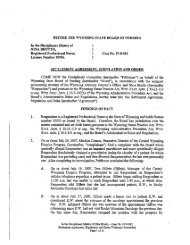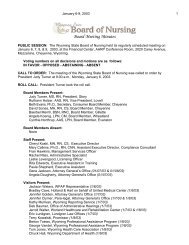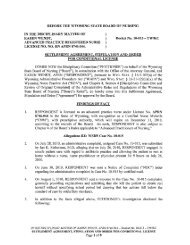Nurse Reporter Spring 2009 - Wyoming State Board of Nursing
Nurse Reporter Spring 2009 - Wyoming State Board of Nursing
Nurse Reporter Spring 2009 - Wyoming State Board of Nursing
Create successful ePaper yourself
Turn your PDF publications into a flip-book with our unique Google optimized e-Paper software.
Sc o p e o f Pr a c t i c e Issues<br />
ADVISORY OPINION<br />
SCOPE OF PRACTICE DECISION TREE<br />
During the January <strong>2009</strong> meeting, the <strong>Wyoming</strong> <strong>State</strong> <strong>Board</strong> <strong>of</strong> <strong>Nursing</strong> voted to adopt a Decision Tree Model for making practice decisions. During that<br />
<strong>Board</strong> meeting, many existing advisory opinions were rescinded since use <strong>of</strong> the Decision Tree Model provided answers to the issues. Using the Decision<br />
Tree Model empowers nurses and nurse administrators to make practice decisions based on the most current information available. National pr<strong>of</strong>essional<br />
nursing organizations (such as American Association <strong>of</strong> Critical Care <strong>Nurse</strong>s, American <strong>Nurse</strong>s Association, American Radiological <strong>Nurse</strong>s Association,<br />
American Society for Pain Management <strong>Nursing</strong>, Emergency <strong>Nurse</strong>s Association, National Association <strong>of</strong> Children’s Hospitals, or American Association<br />
<strong>of</strong> <strong>Nurse</strong> Anesthetists) should be consulted for guidelines. If there is a discrepancy between position statements, the agency is responsible for determining<br />
which position statement is most relevant to the nursing practice in question. If you have further questions, please feel free to contact the <strong>Wyoming</strong> <strong>State</strong><br />
<strong>Board</strong> <strong>of</strong> <strong>Nursing</strong> Practice and Education Consultant (307-777-6127)<br />
Rationale<br />
“The pr<strong>of</strong>ession <strong>of</strong> nursing is a dynamic discipline. Practice<br />
potentials change and develop in response to health care needs<br />
<strong>of</strong> society, technical advancements, and the expansion <strong>of</strong> scientific<br />
knowledge. All licensed nurses share a common base<br />
<strong>of</strong> responsibility and accountability defined as the practice <strong>of</strong><br />
nursing. However, competency based practice scopes <strong>of</strong> individual<br />
nurses may vary according to the type <strong>of</strong> basic licensure<br />
preparation, practice experiences, and pr<strong>of</strong>essional development<br />
activities. The parameters <strong>of</strong> the practice scopes are<br />
defined by basic licensure preparation and advanced education.<br />
Within this scope <strong>of</strong> practice, all nurses<br />
should remain current and increase their expertise and skill<br />
in a variety <strong>of</strong> ways, e.g., practice experience, in-service education,<br />
and continuing education. Practice responsibility,<br />
accountability, and relative levels <strong>of</strong> independence are also<br />
expanded in this way. The licensed nurse is responsible and<br />
accountable, both pr<strong>of</strong>essionally and legally, for determining<br />
his/her personal scope <strong>of</strong> nursing practice. Since the role and<br />
responsibilities <strong>of</strong> nurses, and consequently the scope <strong>of</strong> nursing<br />
practice, is ever changing and increasing in complexity,<br />
it is important that the nurse makes decisions regarding his/<br />
her own scope <strong>of</strong> practice” (Arizona <strong>State</strong> <strong>Board</strong> <strong>of</strong> <strong>Nursing</strong>,<br />
2005).<br />
THE PRACTICE OF NURSING<br />
The Practice <strong>of</strong> Pr<strong>of</strong>essional (Registered) <strong>Nursing</strong> includes the following:<br />
“Practice <strong>of</strong> pr<strong>of</strong>essional nursing” means the performance <strong>of</strong> pr<strong>of</strong>essional services requiring substantial knowledge <strong>of</strong> the biological, physical, behavioral,<br />
psychological and sociological sciences, and <strong>of</strong> nursing theory as the basis for applying the nursing process which consists <strong>of</strong> assessment, diagnosis, planning,<br />
intervention and evaluation. The nursing process is utilized in the promotion and maintenance <strong>of</strong> health, case finding and management <strong>of</strong> illness, injury<br />
or infirmity, restoration <strong>of</strong> optimum function and achievement <strong>of</strong> a dignified death. <strong>Nursing</strong> practice includes but is not limited to administration, teaching,<br />
counseling, supervision, delegation, evaluation <strong>of</strong> nursing practice and execution <strong>of</strong> the medical regimen. The therapeutic plan includes the administration<br />
<strong>of</strong> medications and treatments prescribed by any person authorized by state law to prescribe. Each registered pr<strong>of</strong>essional nurse is accountable and responsible<br />
for the quality <strong>of</strong> nursing care rendered; [WNP 33-21-120, (a) (xi)]<br />
The Practice <strong>of</strong> Practical <strong>Nursing</strong>:<br />
“Practice <strong>of</strong> practical nursing” means the performance <strong>of</strong> technical services and nursing procedures which require basic knowledge <strong>of</strong> the biological, physical,<br />
behavioral, psychological and sociological sciences. These skills and services are performed under the direction <strong>of</strong> a licensed physician or dentist, advanced<br />
practice registered nurse or registered pr<strong>of</strong>essional nurse. Standardized procedures that lead to predictable outcomes are utilized in the observation and care<br />
<strong>of</strong> the ill, injured and infirm, in provision <strong>of</strong> care for the maintenance <strong>of</strong> health, in action directed toward safeguarding life and health, in administration <strong>of</strong><br />
medications and treatments prescribed by any person authorized by state law to prescribe and in delegation to appropriate assistive personnel as provided by<br />
state law and board rules and regulations [WNP 33-21-120, (a) (x)]<br />
Advanced Practice Registered <strong>Nursing</strong>:<br />
“Advanced practice registered nurse (APRN)” means a nurse who:<br />
(A) May prescribe, administer, dispense or provide nonprescriptive and prescriptive medications including prepackaged medications, except schedule I drugs<br />
as defined in W.S. 35-7-1013 and 35-7-1014;<br />
(B) Has responsibility for the direct care and management <strong>of</strong> patients and clients in relation to their human needs, disease states and therapeutic and<br />
technological interventions;<br />
(C) Has a master’s degree in nursing, or an advanced practice registered nurse specialty or has completed an accredited advanced practice registered nurse<br />
educational program prior to January 1, 1999; and<br />
(D) Has completed an advanced program <strong>of</strong> study in a specialty area in an accredited nursing program, has taken and passed a national certification examination<br />
in the same area and has been granted recognition by the board to practice as an APRN [WNP 33-21-120, (a) (i)]<br />
6 Wy o m i n g Nu r s e Re p o r t e r<br />
Continued on page 8



